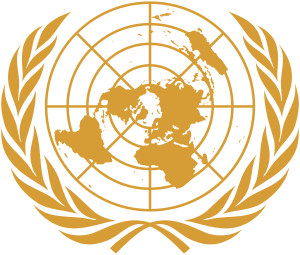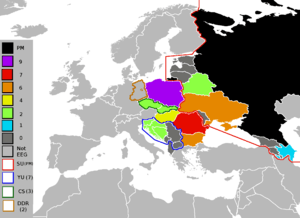Eastern European Group
The Group of Eastern European States (EEG) is one of the five United Nations regional groups and is composed of 23 Member States from Eastern, Central and Southern Europe.[1][2]
 | |
| Abbreviation | EEG |
|---|---|
| Formation | 1964 |
| Type | Regional group |
| Legal status | Active |
Region | Europe |

The Group, as with all the regional groups, is a non-binding dialogue group where subjects concerning regional and international matters are discussed. Additionally, the Group works to help allocates seats on United Nations bodies by nominating candidates from the region.[3][4]
History
Prior to the creation of the Regional Groups in 1964, the United Nations Security Council had an Eastern European and Asian Seat, that was occupied between 1946 and 1964 by countries from Eastern Europe (including Greece and Turkey), as well as by members of the modern Western European and Others and Asia-Pacific Groups.
Since its creation, the Group has changed significantly due to the dissolution of various members: the Soviet Union in 1991, Yugoslavia between 1991-2006 and Czechoslovakia in 1993. Additionally, through the process of German reunification, the Group lost the German Democratic Republic as one of its member states.
Members
Historical members

%3B_Flag_of_Serbia_and_Montenegro_(2003%E2%80%932006).svg.png)

.svg.png)
Representation
The Eastern European Group has two seats in the United Nations Security Council (UNSC); the permanent seat of Russia, and one elected seat, currently held by Estonia. The Group further has 6 seats on the United Nations Economic and Social Council and 6 seats on the United Nations Human Rights Council. It is also eligible for having its nationals elected as President of the United Nations General Assembly in years ending with 2 and 7; most recently, Vuk Jeremić of Serbia was elected to this position in June 2012 and was the office holder of the Sixty-seventh session.
Security Council
The Eastern European Group holds two seats on the Security Council, 1 non-permanent and 1 permanent. The current members of the Security Council from the Group are:[6][7]
| Country | Term |
|---|---|
| Permanent | |
| 1 January 2020 – 31 December 2021 |
Economic and Social Council
The Eastern European Group holds six seats on the United Nations Economic and Social Council. The current members of the Economic and Social Council from the Group are:[8][9]
| Country | Term |
|---|---|
| 1 January 2018 – 31 December 2020 | |
| 1 January 2019 – 31 December 2021 | |
| 1 January 2020 – 31 December 2022 | |
Human Rights Council
The Eastern European Group holds six seats on the United Nations Human Rights Council. The current members of the Economic and Social Council from the Group are:[10][11]
| Country | Term |
|---|---|
| 1 January 2018 – 31 December 2020 | |
| 1 January 2019 – 31 December 2021 | |
| 1 January 2020 – 31 December 2022 | |
Presidency of the General Assembly
Every five years in the years ending in 2 and 7, the Asia-Pacific Group is eligible to elect a president to the General Assembly.[1]
The following is a list of presidents from the region since its official creation in 1963:[12]
| Year Elected | Session | Name of President | Country | Note |
|---|---|---|---|---|
| 1967 | 22nd | Corneliu Mănescu | ||
| 1972 | 27th | Stanisław Trepczyński | ||
| 1977 | 32nd | Lazar Mojsov | Also chaired the 8th, 9th and 10th special sessions of the General Assembly | |
| 1982 | 37th | Imre Hollai | ||
| 1987 | 42nd | Peter Florin | Also chaired the 15th special session of the General Assembly | |
| 1992 | 47th | Stoyan Ganev | ||
| 1997 | 52nd | Hennadiy Udovenko | Also chaired the 10th emergency special and 20th special sessions of the General Assembly | |
| 2002 | 57th | Jan Kavan | Also chaired the 10th emergency special session of the General Assembly | |
| 2007 | 62nd | Srgjan Kerim | ||
| 2012 | 67th | Vuk Jeremić | ||
| 2017 | 72nd | Miroslav Lajčák | Also chaired the 10th emergency special session of the General Assembly | |
| Future | ||||
| 2022 | 77th | TBD | TBD | |
| 2027 | 82nd | TBD | TBD | |
| 2032 | 87th | TBD | TBD | |
Timeline of membership
As the Eastern European Group changed significantly over time, the number of its members had also changed.
| Years | Number of members | Notes |
|---|---|---|
| 1966–1973 | 10 | The Eastern Bloc; Ukraine (as Ukrainian SSR) and Belarus (as Byelorussian SSR) were members on their own right (see here) |
| 1973–1990 | 11 | with the German Democratic Republic |
| 1990 | 10 | German reunification |
| 1991 | 13 | Independence of the Baltic states |
| 1992 | 20 | Dissolution of the Soviet Union, Breakup of Yugoslavia |
| 1993–2006 | 22 | Dissolution of Czechoslovakia, Independence of the Republic of Macedonia |
| 2006–present | 23 | Independent Montenegro |
See also
- Community for Democracy and Rights of Nations
- Community of Democratic Choice
- Council of Europe
- European Neighborhood Policy
- Euronest Parliamentary Assembly
- Eurasian Union
- Eurovoc
- Eastern Europe
- Eastern Partnership
- Future enlargement of the European Union
- List of political parties in Eastern Europe
- Organization for Security and Co-operation in Europe
- Post-Soviet states
References
- Wanza, Serah N. (27 November 2017). "What Are The Five Regional Groups of the United Nations?". Worldatlas. Worldatlas. Retrieved 26 February 2019.
- United Nations Handbook 2018–19 (PDF) (56 ed.). Wellington: Ministry of Foreign Affairs and Trade of New Zealand. 2018. pp. 15–17. ISSN 0110-1951.
- "Latin American and Caribbean Group (GRULAC)". Ministry of Foreign Affairs of Colombia. Ministry of Foreign Affairs of Colombia. n.d. Retrieved 28 February 2019.
- Agam, Hasmy, and Sam Daws, Terence O'Brien and Ramesh Takur (26 March 1999). What is Equitable Geographic Representation in the Twenty-First Century (PDF) (Report). United Nations University. Retrieved 27 February 2019.CS1 maint: uses authors parameter (link)
- "United Nations Regional Groups of Member States". United Nations Department for General Assembly and Conference management. United Nations. n.d. Retrieved 26 February 2019.
- "Current Members". United Nations Security Council. United Nations. n.d. Retrieved 26 February 2019.
- "General Assembly Elects Estonia, Niger, Saint Vincent and Grenadines, Tunisia, Viet Nam as Non-Permanent Members of Security Council for 2020-2021". United Nations Meetings Coverage & Press Releases. United Nations. 7 June 2019. Retrieved 1 January 2020.
- "Members". United Nations Economic and Social Council. United Nations. n.d. Retrieved 26 February 2019.
- "General Assembly Elects 19 Economic and Social Council Members to Terms Beginning 1 January 2020, Adopts Resolution Commemorating Signing of United Nations Charter". United Nations Meetings Coverage & Press Releases. United Nations. 14 June 2019. Retrieved 1 January 2020.
- "Current Membership of the Human Rights Council, 1 January - 31 December 2019 by regional groups". United Nations Human Rights Council. United Nations. n.d. Retrieved 26 February 2019.
- "General Assembly Elects 14 Member States to Human Rights Council, Appoints New Under-Secretary-General for Internal Oversight Services". United Nations Meetings Coverage & Press Releases. United Nations. 17 October 2019. Retrieved 1 January 2020.
- "Past Presidents". United Nations General Assembly. United Nations. n.d. Retrieved 27 February 2019.
- Formerly represented by the Byelorussian Soviet Socialist Republic until 1991
- Formerly represented by the Union of Soviet Socialist Republics until 1991
- Permanent member of the United Nations Security Council
- Formerly represented by the Ukrainian Soviet Socialist Republic until 1991